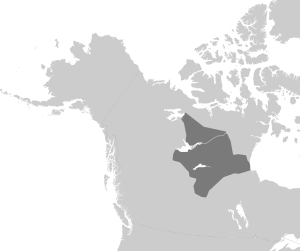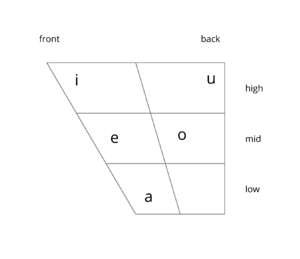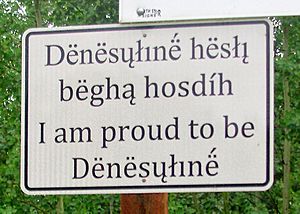Chipewyan language facts for kids
Quick facts for kids Chipewyan |
||||
|---|---|---|---|---|
| Denesuline ᑌᓀ ᓱᒼᕄᓀ ᔭᕠᐁ Dëne Sųłinë́ Yatıé |
||||

Dënësųłinë́ sign at La Loche Airport
|
||||
| Native to | Canada | |||
| Region | Northern Alberta, Saskatchewan, Manitoba; southern Northwest Territories and Nunavut | |||
| Ethnicity | 30,910 Chipewyan people | |||
| Native speakers | 11,325, 41% of ethnic population (2016 census) | |||
| Language family |
Dené–Yeniseian?
|
|||
| Dialects |
Dëne Sųłınë́ Yatıé
Dëne Dédlıné Yatıé
Tthetsánót’ıné Yatıé
Tetsǫ́t’ıné Yatıé
|
|||
| Writing system |
|
|||
| Official status | ||||
| Official language in | Canada (Northwest Territories) | |||
 |
||||
|
||||
Chipewyan or Denesuline is a language spoken by the Chipewyan people in northwestern Canada. The people themselves often call their language Dëne Sųłinë́ Yatıé, which means "the language of the Dene people." It belongs to a larger group of languages called the Northern Athabaskan language family.
About 12,000 people in Canada speak Dënësųłinë́. Most of them live in Saskatchewan, Alberta, Manitoba, and the Northwest Territories. In the Northwest Territories, Dënësųłinë́ is one of nine Indigenous languages that have official status. This means it's recognized and used by the government there.
Many Chipewyan people today prefer to use the names "Dene" for themselves and "Dënësųłinë́" for their language. This is true for communities like Fond-du-Lac, Black Lake, Wollaston Lake, and La Loche in Saskatchewan.
Contents
Sounds of Dënësųłinë́
Every language has its own unique sounds. Dënësųłinë́ has many different sounds, including 39 consonant sounds and 24 vowel sounds.
Consonant Sounds
The consonant sounds in Dënësųłinë́ are made using different parts of your mouth, like your lips, teeth, and tongue. Some sounds are made by stopping the air completely, like 'p' or 't'. Others are made by letting air flow through a narrow space, like 's' or 'sh'. Some sounds are also made with a quick burst of air, which is called "aspiration."
Vowel Sounds
Dënësųłinë́ has six main vowel sounds, similar to the 'a, e, i, o, u' in English, but with more variations. These vowels can be either oral (air comes out only through the mouth) or nasal (air comes out through the nose and mouth, like the 'on' in French "bon"). Also, vowels can be short or long, which means you hold the sound for a shorter or longer time.
Diphthongs
A diphthong is a special vowel sound that starts in one position and moves to another within the same syllable. Dënësųłinë́ has nine diphthongs, which are combinations of a vowel sound followed by a 'y' sound.
Language Tone
Dënësųłinë́ is a tone language. This means that the meaning of a word can change depending on the pitch of your voice when you say it. It has two main tones:
- High tone: The voice goes up or stays high.
- Low tone: The voice goes down or stays low.
Where Dënësųłinë́ is Spoken
In 2011, about 11,860 people in Canada said that Dene was their first language. Most of these speakers live in Saskatchewan and Alberta.
Here's a breakdown of where Dënësųłinë́ speakers lived in 2011:
- Saskatchewan: 7,955 people
- Alberta: 1,680 people (this includes some speakers of Dene Tha', a related language)
- Manitoba: 1,005 people
- Northwest Territories: 450 people
- Smaller numbers in British Columbia, Yukon, and Ontario.
The Dënësųłinë́ language is mainly spoken in the traditional areas of the Chipewyan people, which are south and east of Great Slave Lake.
Saskatchewan Communities
The Dënësųłinë́-speaking communities in Saskatchewan are in the northern part of the province. In 2011, 7,410 people in this area chose Dene as their first language.
Many speakers live around Lake Athabasca and the Fond du Lac River. Key communities include:
- Fond-du-Lac: 705 speakers out of 874 residents.
- Stony Rapids: 140 speakers out of 243 residents.
- Black Lake: 1,040 speakers out of 1,070 residents.
- Wollaston Lake (Wollaston Post): 1,165 speakers out of 1,251 residents.
Another large group of speakers lives in the upper Churchill River area. Important communities here are:
- La Loche: 2,300 speakers out of 2,611 residents.
- Clearwater River: 720 speakers out of 778 residents.
- Dillon (Buffalo River Dene Nation): 330 speakers out of 764 residents.
- Patuanak: 265 speakers out of 482 residents.
Manitoba Communities
There are two communities in northern Manitoba where Dënësųłinë́ is spoken. These communities use a special writing system called Déné Syllabics for their language.
- Lac Brochet: 720 speakers out of 816 residents.
- Tadoule Lake: 170 speakers out of 321 residents.
Alberta Communities
In northeastern Alberta, especially in the Wood Buffalo-Cold Lake area, there are about 510 Dënësųłinë́ speakers. Some communities include:
- Fort Chipewyan: 45 speakers out of 847 residents.
- Janvier: 145 speakers out of 295 residents.
- Cold Lake 149: 105 speakers out of 594 residents.
Northwest Territories Communities
South of Great Slave Lake in the Northwest Territories, about 260 people speak Dënësųłinë́. Key communities are:
- Fort Smith: 30 speakers out of 2,093 residents.
- Fort Resolution: 95 speakers out of 474 residents.
- Lutselk'e: 120 speakers out of 295 residents.
See also
 In Spanish: Idioma dené suliné para niños
In Spanish: Idioma dené suliné para niños
- Chipewyan syllabics
- Chipewyan people




